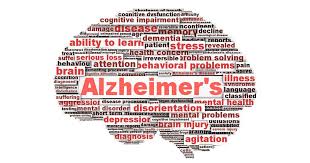Alzheimer's Disease: A Poorly Understood Neurodegenerative Disease

What is Alzheimer's Disease ?
Alzheimer's Disease (AD) is also known as Alzheimer's. It a common neurodegenerative disease and it usually starts slowly but overtime, it slowly and gradually worsens and eventually leads to the death of the patient. It the most common cause of dementia (about 60-70% of the time). The disease starts with symptoms like difficulty in remembering the recent events. But as the disease progresses, other symptoms like disorientation, problems with speech, mood swings, behavioural issues etc. can also be detected. Gradually, the body becomes unable to function and the patient dies.
AD is a poorly understood disease that can be caused by genetically issues, head injuries, depression etc. In 2015, about 30 million people in the world was recorded as AD patient. Currently, there is no treatment available to stop or reverse the progression of AD. But maintaining rules, doing exercises, taking therapies etc. can make the life the patient quite easier.
In developed countries, AD is one of the most financially costly diseases.
Signs and symptoms
Different symptoms can be detected at different stages of Alzheimer's disease:
At the early stage:
1. Difficulty in remembering the past events or older memories of the patient's life.
2. Forgetting the names of near and dear ones.
3. Short-time or long-time memory loss.
At the middle stage:
1. Sleeping problems.
2. Confusion on many circumstances.
3. Greater difficulty remembering recent incidences.
At the late stage:
1. Speaking problems.
2. Problems with language.
3. Stressful and anxious behaviour.
4. Disorientation and mood swings.
Causes
The causes of AD are still not clearly known. But there are some hypotheses regarding the disease. Three major hypotheses are briefly discussed below:
Genetic cause and Amyloid hypothesis:
AD is found to be genetically inherited in many patients. About 0.01% of the cases are familial forms of autosomal dominant inheritance, that have an onset before age 65. The familial AD is caused by mutations in any one of the three genes that encode Amyloid Precursor Protein (APP) and Presenilins 1 and 2. Due to these mutations, the production of a small protein (contains about 42 amino acids) called A-beta-42 (also called Beta amyloid) is increased and deposited. This protein is the main component of senile plaques. The deposition of beta amyloid is the fundamental cause of AD. Again, mutations in two other genes called ' ABCA7 and SORL1' are also responsible for AD.
Again, the inheritance of of the ε4 allele of apolipoprotein E is also responsible for AD. The presence of ε4 allele increases the risk of disease by three times in heterozygotes and fifteen times by homozygotes. This allele is also a major genetic risk factor for AD.
Cholinergic hypothesis:
Most of the drugs that are generated so far against the AD, are based on this hypothesis. This hypothesis states that, AD is caused due to reduced synthesis and secretion of acetylcholine (a potential neurotransmitter).
Tau hypothesis:
According to this hypothesis, tau protein abnormalities is the main reason of onset of AD. Hyperphosphorylated tau protein begins to form pair with other tau proteins and eventually form neurofibrillary tangles in the interior of the nerve bodies. This leads to the destruction of cytoskeleton and interfering with the neuron's transport system.
Accoding to
Mechanism
The underlying mechanism of AD is dependent of the misfolding of proteins. The misfolded beta-amyloid protein and tau protein are accumulated to form neuritic plaques,
The Amyloid Precursor Protein (APP) is a transmembrane protein that connects the interior of a neuron to the exterior environment of the cell. APP is necessary for proper development of the neuronal cells. But in AD, two enzymes, beta-secretase and gamma-secretase cut the APP protein proteolytically and produce the beta-amyloid fragment proteins that are misfolded and form plaques. Thus beta-amyloid accumulation causes Alzheimer's Disease.
Diagnosis
AD is normally diagnosed base on the family history of patient and behavioural observations. Now-a-days, advanced technologies such as Computed Tomography (CT), Magnetic Resonance Imaging (MRI), Positron Emission Tomography (PET) etc. are for the detection of AD.
Treatment and management
There is no treatment and medication available to treat AD. Recently, five medicines are used in treatment but their effect is very low. Four of them are acetylcholinesterase inhibitors and the other one is an NMDA antagonist.
But the diseases associated with AD, can be treated well. For example, heart diseases, hypercholesterolaemia, hypertension, diabetes etc. can be treated by various drugs. But changing the lifestyle of the patient is the main treatment of the disease. Doing intellectual activities like reading, playing music, playing board games etc. have shown to reduce the risk for AD. The AD diseases people should be kept in periodic counseling, different types of therapies and physical activities and family support is essential to make their life a little bit easier for them. Changing and maintaining a healthy diet and regular exercises are also recommended by the doctors.








